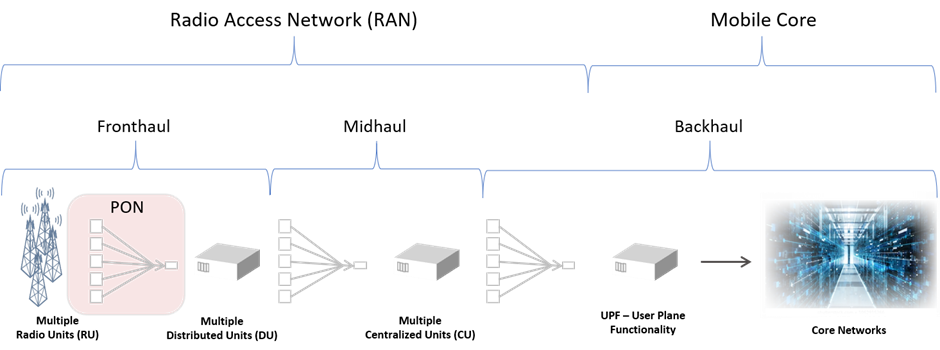Based on “The Case for Using PON for 5G Fronthaul,” an article written by Ethernity CEO David Levi and recently featured in Lightwave Magazine
While we have been promised 10 Gbps download speeds with 5G, an order of magnitude higher than its 4G predecessor, there are inherent challenges in 5G infrastructure. The major tradeoff of 5G technology is higher speed (bandwidth) at the cost of shorter range. 5G uses millimeter waves which reduces the signal reach from about a kilometer with 4G to 100 meters or less in 5G.
Because of this limitation, 5G requires up to 50 times more antennae than 4G does. In order to attain full coverage in China, for example, tens of millions of towers will need to be deployed.
This poses a serious question for 5G operators:
How Will All These Towers be Connected?
Before attempting to address this challenge, we need to understand the basic configuration of the 5G network. The radio tower base station used for 4G will be split into a separate radio unit (RU) and distributed unit (DU) in the 5G network architecture. The RU receives and converts the digital signal from the radio tower, while the DU processes and forwards data. This change is crucial as the number of towers is multiplied in 5G, since it allows DUs to be relocated to telco edge central offices, saving cost and size of the RU base stations.

Fiber is the logical choice to bridge this new physical separation between the RU and DU. However, 5G has much stricter requirements for low latency and high bandwidth capacity than was needed for previous generations.
While the most straightforward solution would be to set up new fiber to connect these millions of towers, the cost and time delay involved would be prohibitive.
Instead, a far better method for connecting 5G towers to the Radio Access Network (RAN) is to utilize the preexisting Passive Optical Network (PON) that is currently being used for Fiber-to-the-Home/Business (FTTx). Existing FTTx networks are large and extensive, with sufficient line and port resources as well as the necessary optical devices and power supply. PON offers resilience, such that connectivity is maintained even if a line is disconnected. Most of all, PON reduces networking costs by reusing existing fiber and optical filters, and it can handle various traffic streams with much greater capacity than other transport options.
But can PON support the high requirements necessary for 5G connectivity? The two main benchmarks that must be satisfied are bandwidth and latency. Let’s look at each.
Can PON Handle the Necessary Bandwidth?
Currently, there are several standards used by PON. FTTx may use GPON, which does not support enough bandwidth to handle 5G fronthaul. Using the XGS-PON or 25G PON standards, however, would certainly fulfill 5G requirements, as they can handle 10 or 25 Gbps (respectively) both upstream and downstream. In order to provide this without changing existing broadband lines, operators can take advantage of Wave Division Multiplexing (WDM) to overlay different types of PON on the same physical line. With WDM-PON, the same optical fiber can be used for GPON broadband for FTTx and XGS‑PON for 5G mobile fronthaul, with each service using distinct wavelengths. To differentiate them, a special receiver is needed, while the underlying fiber can remain as is.
Another flavor of PON is also showing promise. NG-PON2 can support up to 40 Gbps in each direction, and could potentially extend the reach of the PON network within 5G to the Central Unit, even deeper into the RAN.
The Final Hurdle: Latency
If we can use existing fiber to greatly reduce cost and time invested into 5G, and we can use XGS‑PON with WDM to improve the bandwidth capacity of the fiber, the last remaining question is whether PON can fulfill 5G’s very low latency requirements.
PON is a type of TDMA protocol, which means there is a delay between the arrival of traffic and delivery that could be as great as one millisecond. In 5G, that could certainly be problematic. However, WDM-PON has shown promise as a low-latency option for 5G fronthaul transport.
Although there is no consensus yet of how to best handle the issue of latency, several other possible solutions have been proposed. As 5G networks continue to be deployed, more work will undoubtedly go into this to meet 5G latency requirements.
Either way, PON is certainly the best solution for 5G fronthaul transport, because it is already available and provides one network that supports both broadband (FTTx) and 5G cellular. Moreover, PON is scalable, easy to install and configure, and very reliable. Most importantly, it offers a significant cost saving to 5G operators at a time when they are investing heavily into the high number of towers necessary for full 5G deployment.
Read the full article at Lightwave Magazine

By Brian Klaff

